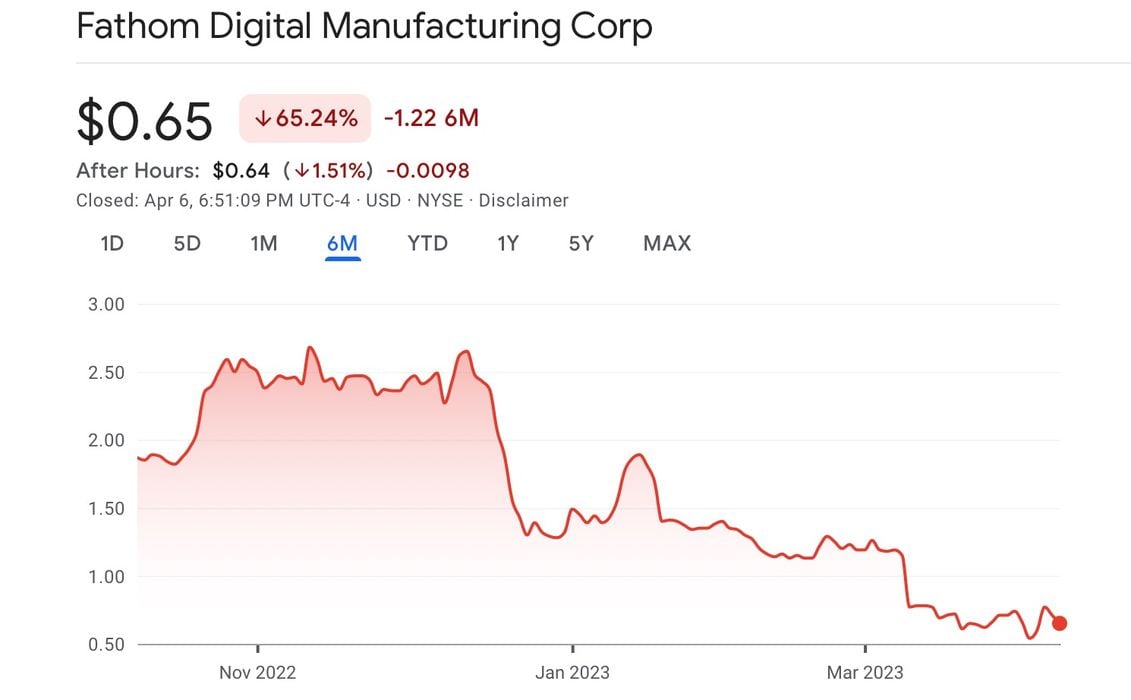
Once again we take a look at the valuations of the major 3D printing companies over the past week.
Publicly traded companies are required to post their financial reports, as well as appear on stock markets. From there we can calculate the total value of their company by multiplying the current stock price by the number of outstanding shares. This number is the market capitalization, and represents the current valuation of the company.
It’s a great number of compare companies, as the market capitalization can be leveraged to provide more capabilities for the company. Shares could, for example, be used as collateral for a loan. That and similar maneuvers could generate cash with which the company might undertake new projects.
In other words, “market cap”, as it is known, is quite important.
You might think it’s not important to monitor these companies each week, as their value is realized only when stocks are sold. However, events happen to companies occasionally that cause their value to rise and fall, and this weekly post is where we track such things.
Note that our list here does not include all major 3D print companies. Not all 3D print companies are publicly traded, and thus we cannot officially know their true size, such as EOS. Others, like HP or Siemens, have very large 3D printing divisions, but are part a much larger enterprises and we cannot know the true size of their 3D printing activities.
Let’s take a look at the 3D printing companies on this week’s list.
3D Printing Leaderboard
| RANK | COMPANY | CAP | CHG |
| 1 | 3D Systems | 1,262 | -144 |
| 2 | Stratasys | 1,026 | -88 |
| 3 | Protolabs | 832 | -53 |
| 4 | SLM Solutions | 654 | -8 |
| 5 | Xometry | 649 | -65 |
| 6 | Nano Dimension | 646 | -97 |
| 7 | Desktop Metal | 644 | -89 |
| 8 | Materialise | 470 | -20 |
| 9 | Velo3D | 375 | -62 |
| 10 | Markforged | 173 | -14 |
| 11 | FATHOM | 89 | +14 |
| 12 | Steakholder Foods | 45 | 0 |
| 13 | Massivit | 37 | -1 |
| 14 | Freemelt | 30 | -1 |
| 15 | voxeljet | 20 | +3 |
| 16 | Titomic | 19 | -0 |
| 17 | Shapeways | 14 | -3 |
| 18 | AML3D | 11 | -0 |
| 19 | Sigma Additive Solutions | 11 | 0 |
| 20 | Sygnis | 10 | +1 |
| 21 | Aurora Labs | 4 | +0 |
| 22 | Tinkerine | 1 | +0 |
| TOTAL | 7,023 | -627 |
This week saw a pretty hefty decline overall, with the leaderboard shedding over eight percent of last week’s value. This is extremely curious, because the markets as a whole were up on the week by about a percent. For the 3D printing market to drop is quite a divergence. I am now wondering whether there has been a general feeling of manufacturing decline among major investors?
As usual, some companies on the leaderboard disagreed with the average and went their own way.
The winner of the week was no doubt FATHOM, which managed to raise their valuation by almost 20% — that in a week when the leaderboard dropped by eight percent. However, this really is not material, as you can see in this long-term chart:

FATHOM is still way down from their prior highs, and this week’s bump was basically noise. However, the company did announce they have received official Notice Of Noncompliance from the NYSE that their 30-day average stock price has fallen below US$1, and that they risk de-listing if not rectifying the situation within six months. FATHOM indicated they intend on responding to the situation in a “timely manner”.
Another winner was voxeljet, which recently reported their 2022 financials, with a rise in valuation of 18% this week. The company reported an increase in revenues from 2021 by twelve percent, and a net loss of €6M for the year, which is worse than 2021. However, it seems they have improved their operating net results and took some one-time write-downs that made the overall result worse than the company’s true state. It seems that investors believe in voxeljet, resulting in their bump this week.
It’s important to note that voxeljet is a very unusual company in that they sell massive systems. Each sale is worth a considerable amount, and they don’t make very many each year. While some 3D printer manufacturers might sell tens of thousands of units in a year, voxeljet sold only 15 systems in 2022. Thus, a single sale or two can dramatically affect their valuation.
Then there were a few companies on the wrong side of the average.
One was Shapeways, where their valuation plummeted yet again, with an 18% loss in value this week. Their financials were also reported in the past week, and there were several negative signals. Their revenue dropped slightly, as did their margins. More importantly, their net loss increased from US$4.5M to a whopping US$19.8M.
Like FATHOM, Shapeways is also on notice from the NYSE for having such a low stock price. The company intends on doing a reverse-stock split in coming months, which would raise the stock price to appropriate levels, but each investor would have proportionally fewer shares.
This is a symptom of the company’s troubles. When they first went public back in October of 2021, their valuation was in the US$500M range. That is very hard to comprehend, given their current valuation of a mere US$14M. They are down 97.5% in value from their highest point, which must be extraordinarily disappointing for their shareholders.
This week Velo3D somehow dropped in value by 14%, double the leaderboard average. As usual, I cannot find any particular reason for this, as Velo3D’s value bounces up and down quite erratically usually for no apparent reason. This is in spite of them announcing several high-profile sales of major equipment this week, which should have boosted their valuation.
Finally, we come to the ongoing corporate saga between Stratasys and Nano Dimension. If you haven’t been plugged in, Nano Dimension is in a massive legal battle with their own shareholders regarding the use of a huge US$1.1B cash hoard. Company management wants to spend it on acquisitions, but shareholders seem to have little faith in company management to execute successfully and want to change management immediately.
There have been a series of offers by Nano Dimension and rejections by Stratasys, and I’m anticipating another rejection sometime early next week.
How has the controversy affected these companies this week?
Stratasys incurred a bit of a boost when the offers started arriving, and has largely managed to maintain them. This week the company also announced a major healthcare deal that could generate huge growth in the future. Stratasys lost eight percent in value, about the average for the leaderboard this week — so pretty much flat.
On the other hand, Nano Dimension’s value fell over 13% this week. The company has suffered declines in value since the takeover sage commenced. What’s even more extraordinary about this situation is that Nano Dimension’s valuation, US$646M, is about half of their cash reserve. How can you be worth less than what’s in your bank account? I think that tells you what investors think about company management’s proposal to use the money on acquisitions: they almost certainly believe such investments will be wasted.
Upcoming Changes
A company set to appear was Essentium, who announced plans to use a SPAC-merger to launch on NASDAQ. However, that deal has been suspended so we’re wondering what the company’s next steps might be.
One company I’ve started to watch is ICON, the Texas-based construction 3D printer manufacturer. This privately-held company has been raising a significant amount of investment to the tune of almost half a billion dollars. At that level it is likely they will be discussing a transition to public markets at some point, which would certainly place them at or near the top of our leaderboard.
Another company that would seem logical to go public is VulcanForms, a manufacturing service using an advanced metal 3D printing process. They are currently privately valued at over US$1B, and going public could cause that to go even higher.
If you are aware of any other publicly-traded 3D print companies that should be on our leaderboard, please let us know!
Others In The Industry
While we’ve been following the public companies, don’t forget there are a number of private companies that don’t appear on any stock exchange. These privately-held companies likely have significant value, it’s just that we can’t know exactly what it is at any moment. The suspected bigger companies include EOS, Carbon and Formlabs.
Perhaps someday some of them will appear on our major players list.
Related Companies
Finally, there are a number of companies that are deeply engaged in the 3D print industry, but that activity is only a small slice of their operations. Thus it’s not fair to place them on the lists above because we don’t really know where their true 3D print activities lie.
